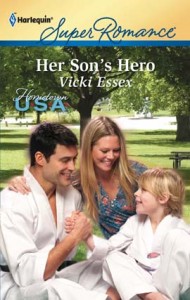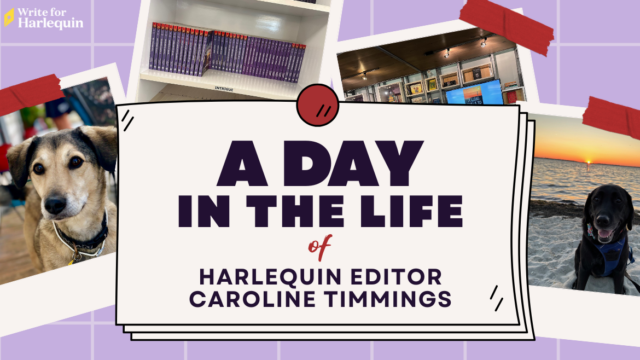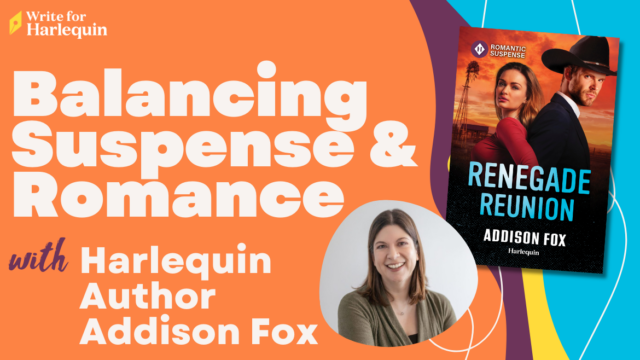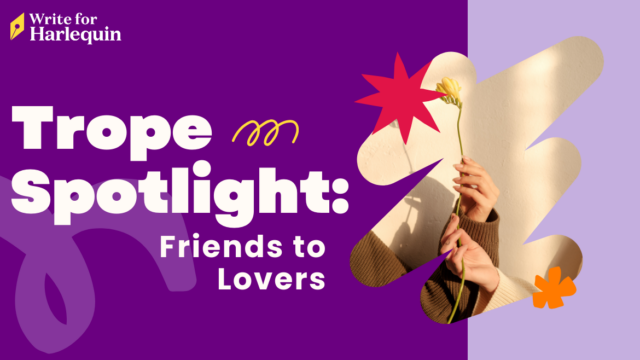Read on, and don’t forget to join the conversation on Twitter by using the hashtag #sytycw.
At the heart of a great romance are characters we can relate to and fall in love with. Harlequin Superromance author Vicki Essex talks about writing diverse, memorable and fully realized characters.

Vicki Essex @VickiEssex
While writers talk about goal, motivation and conflict being the driving force of all stories, characters are often what make your stories memorable. Good characters are vital to defining the path your tale will take. Who and what they are ultimately drive their motivations; their pasts and experiences steer them toward particular choices, which in turn lead to consequences that can either support or destroy their existing beliefs.
Creating strong, compelling, sympathetic, interesting and memorable characters will not only make your story stand out, but it will also help you understand your story better.
Here are my tips for creating complex, interesting and unforgettable characters.
The Basics
Whether you’re a plotter or a pantser, keep a record of all the vital stats about your main characters and any secondary characters who play a larger role in your story. I keep a spreadsheet with these basic facts:
- Full name (and nicknames)
- Age
- Birthday
- Eye and hair color
- Height & weight
- Ethnicity and birthplace
- Occupation
- Education
- Kind of car(s) or vehicles they drive
Keeping this list, and adding anything you think might play into the story later, will help you keep track of who’s who, and will save you from reading back to see whether your heroine’s eyes were sky blue or emerald green.
Additional facts you can track include:
- Childhood upbringing
- Immediate family members (names, ages, and defining trait)
- Primary romantic conflict
- Main foible(s)/flaw(s)
- Special skills
- Notable physical traits (scars, tattoos, piercings, accessories, mobility devices, etc.)
It’s also a good idea to keep a running list of names of all characters and their relationship to your MCs in your story.
Give Them a Code
 In the immortal words of Luke Evans in Fast and Furious 6, “Every man has to have a code.” This is your character’s iron-clad rule that they will not, under any circumstances, break. Not every character has a code, but if you’re writing a particularly challenging character, someone you might not even like because of the things they do or the people they hang out with, giving them a code might go a long way to redeeming them or explain who they are. It’s particularly effective if you give a villain or an anti-hero a code—for example, “I will not hurt or kill children,” or “I will do anything and kill anyone to save my baby.” Codes push characters into moral gray areas, giving them depth while also making them sympathetic.
In the immortal words of Luke Evans in Fast and Furious 6, “Every man has to have a code.” This is your character’s iron-clad rule that they will not, under any circumstances, break. Not every character has a code, but if you’re writing a particularly challenging character, someone you might not even like because of the things they do or the people they hang out with, giving them a code might go a long way to redeeming them or explain who they are. It’s particularly effective if you give a villain or an anti-hero a code—for example, “I will not hurt or kill children,” or “I will do anything and kill anyone to save my baby.” Codes push characters into moral gray areas, giving them depth while also making them sympathetic.
Choosing Points of View
Point of view is one of the trickiest skills to master. Most fiction is written in either first- or third-person point of view, though sometimes you find second-person (as in Choose Your Own Adventure stories). POVs are further categorized into limited and omniscient; some authors have successfully blended them, but I tend to stick to one type of POV at a time. I recommend reading this article at The Beginning Writer to learn more.
At Harlequin, most series category books use third-person limited or omniscient point of view, and many young adult and single title books are first person. But that doesn’t mean you can’t submit something different. The important thing is to write what feels most natural to you and to ensure the readers stay immersed in your story. Too much head-hopping and too many jarring transitions between characters with meandering and mundane narratives can confuse, bore or aggravate the reader.
In my Harlequin Superromance books, I mainly use third-person limited, and keep the narrative between the hero, heroine and possibly a third B-plot character. Keeping the story framed within certain characters’ POVs helps me keep readers close to the emotions of those characters. This is part of achieving deep point of view. If you are using more than one character’s POV in a story, then for each scene, center your POV on the character who has the most to lose, or who has the most at risk in that moment.
Diversity and Multiculturalism
There’s been lots of discussion and even an online movement (#WeNeedDiverseBooks and #WeNeedDiverseRomanceBooks) advocating stories featuring more diverse characters. If you’re looking to write characters of different races, sexual orientations, religions, abilities and so forth, make sure you do your research. Throw out all your assumptions and seek out the issues these groups face, how they are being discriminated against, what kinds of barriers and challenges are a part of their everyday lives, and so forth.
Avoid stereotypes, tokenism and fetishization. The world is full of lots of different kinds of people, and your worlds should reflect that diversity.
For more on portraying racially diverse characters, please check out my article at Romance University.
Make Them Unique
How do you make your Italian billionaire CEO stand out in a crowd of other billionaire CEOs? Avoid clichés and stereotypes. Surprise us. What if instead of yacht racing, your CEO was a champion video game player? What in his past made him unique? Even if it’s a little thing, bucking the trend speaks volumes about who your characters were, who they are, who they long to be, and how they’ve had to conform or change themselves in order to become the person they are now.
Give your characters a unique or unusual talent or skills that run counter to the reader’s expectation. If your heroine is a sweet single mom who runs her household with military precision, maybe it’s because she was a former soldier who was also an academy goofball. Be specific in these unique traits and ask yourself how other characters perceive that particular reveal. For instance, in my Harlequin Superromance book In Her Corner, the hero, a former wrestling champion, uses his favorite board game to ultimately seduce the heroine into his bed. Showcasing his nerdier side put her at ease with him despite his overt masculinity.
Character Arcs
All characters (except the villain, though that can be argued) have a character arc. Even the minor ones. It doesn’t have to be huge, but everyone should change over the course of a story. For example, in Her Son’s Hero, the heroine’s ten-year-old son, Sean, transforms from an angry adolescent into a wise, forgiving young man under the guidance of his karate teacher. And in A Recipe for Reunion, bakery employee Kira goes from being overprotective and secretive about her home life to accepting help from the people around her.
Oftentimes, side characters have even bigger transformations that the main characters. 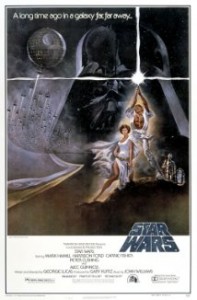 For example, Han Solo from Star Wars goes from being a mercenary pilot for hire who’d prefer to run to being a hero of the Republic. It’s a complete 180 compared to Luke’s own progression from farmboy to galactic hero.
For example, Han Solo from Star Wars goes from being a mercenary pilot for hire who’d prefer to run to being a hero of the Republic. It’s a complete 180 compared to Luke’s own progression from farmboy to galactic hero.
Your hero and heroine don’t necessarily have to have the biggest character arcs in the story, though their arcs should be fairly notable and result directly in their happy-ever-after. For example, if your hero is trying to get over a past betrayal, then his arc must take him from unforgiving to forgiving. If your heroine is afraid of disappointment, then she must come to terms with life’s many twists and turns and find a deeper understanding of why she is afraid, and what made her feel that way.
Why Is This All Important?
If you get nothing else out of this article, remember this: Story happens when motivated characters make choices that result in unforeseen consequences. Every choice has an associated reward and cost. The characters must choose according to their own personalities, experiences and risk tolerance, which is why it is so important you understand who your characters are to begin with. The reader will know immediately when they’ve acted out of character, when they (or you, as the author) can’t justify their actions or choices, or they run completely counter to their experience.
Putting It All Together
Okay, so you’ve got a great character. But their existence on paper isn’t enough. You’re not interesting if all you do is stand around and pretend to look interesting. You have to give them something to do.
Make Your Characters Face Conflict: Give them a challenge. It doesn’t have to be a mortal enemy; it can be something as simple as handing Captain Hook a jar of pickles to open…and then having a monkey steal his hook. What does he do? Shoot the monkey? Chase it? Try to lure it with a banana? Order his crew to go after it?
Make Your Characters Choose: When a character makes a choice based on their past experiences and personality, they have closed themselves off from other actions.
Captain Hook is proud and doesn’t tell his men a monkey has bested him. He hesitates at shooting the monkey because he doesn’t want to ding his hook. In doing so, the monkey absconds with his hook into the forest. Hook now has no choice but to chase him alone on foot.
Make Your Characters Do the One Thing They Would Never Do: What is so important in your character’s life that they would go against all their instincts and do the one thing they swore they’d never do to achieve their goal? How can you make your characters face their greatest fear? If your heroine is afraid of spiders, but the hero is trapped in a deep dark cave full of tarantulas with a broken leg and no way out, make her go in. The greater the personal risk, the greater the reward.
Hook chases the monkey to an area that clearly shows signs of the presence of his nemesis, the Crocodile. He would never walk in alone and unarmed, but if he loses sight of the monkey, goodbye hook.
Make It Worse: Now raise the stakes. Your character is facing her greatest fear; how can you make this so much worse? Push them to the breaking point, then make them persevere—or don’t!
The monkey climbs a tree and teases Captain Hook. When Hook picks up a rock to throw at it, he puts his hand in a big pile of crocodile poop instead. His one good hand is now covered in crap.
And When They Get the One Things They Desire the Most, Make It the Worst Thing They Can Possibly Have: Your character’s choices and actions have led them to their goal. But it can’t be a complete victory. Every win comes at a cost; every opportunity has a drawback.
Infuriated, Captain Hook curses the monkey until the air turns blue. The monkey screams and drops the hook into the bushes. Triumphant, Captain Hook doesn’t hear the tick-tock of the Crocodile’s clock until the monster lumbers from the bushes…with the pirate’s hook resting atop his head.
Now Make Sure They Can Redeem/Save Themselves (or at least allow themselves to be rescued): Your character’s ability to save himself isn’t dependent on how easily they can manage to get out of a crisis on their own—if it’s too easy, then it wasn’t a challenge. Everyone needs a little help sometimes; as long as the help received flows with the rescuer’s characterization and motivations, and you can avoid deus ex machina you are well on your way to redemption.
Hook runs back to the ship, Croc on his tail, screaming for the crew to save him. Smee swoops to the rescue, chases the crocodile away, and manages to snatch the hook back. As Hook thanks him and the crew for their quick thinking, Smee opens the jar of pickles for his captain. The end.
Final Thoughts on Characters
Don’t get hung up on making every single character brilliant and witty and stand out like a clown at a funeral. Some of the most interesting characters are quiet and thoughtful. Others may seem boring until they say or do that one amazing thing.
The world is made up of all kinds of folks, and so should your fictional world. Different characters have different roles to play, and often they’ll play more than one role, or their role might change.
Study character archetypes and use them, but put your own twist on them.
Make sure your characters are always active, taking initiative, driving themselves toward a goal.
The better you know your characters and how they’ll react to different scenarios, the better your story will be.
Further reading:




